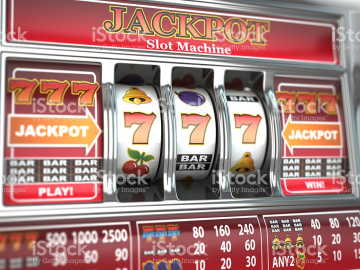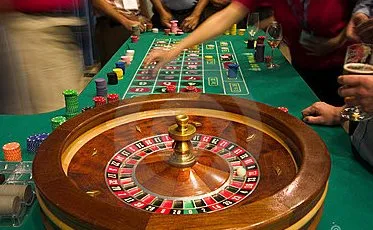


This blog does not encourage the reader to gamble in casino but highlights the statistical and probability reasoning in the casino games which are largely governed by the Law of Averages, for general interest.
When you are in a casino for a good time, remember a simple guideline that the easier a game is to understand, the worse the odds usually are against you. This is certainly the case with slot machines.
There is no skills demanded in playing the slot game to improve your odds as long as you know where to press a button to set the machine reels in motion. Every spin is independent of all past spins. It means that for a given machine game, the odds are always the same as the outcome of every spin is ultimately determined by the programmed random number generators in the machine. It makes no difference when the last jackpot was hit or how much the game paid out in the last hour, day or any period of time.
Indeed, slot machines like some other casino games are a type of game for which there is no winning strategy for you to apply. The outcome is already predestined the moment you press the GO button and the odds are totally unknown to the players like you as these odds are not quantifiable. Unlike a blackjack game against real opponents, for example, you may have proper application of skill or strategies to make a game profitable in the long term, such as distraction and intimation to make the casino dealers losing concentration and making mistakes in the games.
In case of slots, you encounter a high house edge (the profit margin can be 2-5% or so arbitrarily set by the casinos) and fast turnaround time of play, as compared with other casino games. There is no way to make money in the long term. The Law of Averages ultimately will let the casino win.
However many people tend to enjoy the thrill of such a game in casinos even if they know or merely suspect that is a negative equity investment of their money because of the house edge (profit margin for the house).
So the interesting question is: Why play since we know there is always a house edge? Of course, there is always a chance that you may get lucky in the session to hit the jackpot or some good returns. You may also find playing slots can be a cheap form of entertainment if you faithfully stick to a budget and are disciplined enough to quit when the target of making or losing a certain set percentage of your bankroll.
An advice from experts is that you should not be too ambitious in the goals, such as aiming to stay until doubling your bankroll. More modest aims have more chance of being achieved, say 50% of your bankroll. Do not fall for any absurd belief about ‘riding my luck’ if you reach your target early. Take your money and run before the beast of randomness wakes and consumes all your cash.
Let’s look at an example of a hypothetical simplified slot machine with three reels and ten fruit symbols on each reel. And, there is only one pay-out, the “Jackpot”, for matching three same fruit symbols in a row and you need to match three of the same to win the jackpot on this $1 machine.
So the chance of hitting, say a banana symbol on one reel is 1/10 and the chance of hitting a banana on the second reel is also 1/10. Therefore the chance of hitting three bananas in a row is 1/10 x 1/10 x 1/10 or 1/1000, or 0.010%. The chance looks bleak but your odds of winning are actually better than this because you can also hit any one of nine other sets of fruit symbols. So on this machine, your odds of any set of three identical symbols are actually 10 x 0.10% or 0.10%. Therefore theoretically once in every 100/0.10 or 1000 spins of this hypothetical machine, you will hit your set of three identical symbols for the jackpot.
If the jackpot payout is $ 1000, the machine would be a break-even proposition as on average you would put up the $1 bet for 999 times without winning anything, and then you’d hit once in the 1000th spin for the $1000 prize, breaking even overall. Pay-outs are usually set by the casinos at a slightly lower figure, usually between 95% and 98% of this frequency, so for example if this imaginary machine is set for 95% pay-outs, the jackpot would actually be $950, instead.
Of course, you can be very lucky and hit jackpot on your second spin to walk away with the $950 prize, technically making a hefty profit for $2 bets. But on long-term speaking, there is no way to beat the Law of Averages and the house edge will be sustained over any short-term variance in results.
Of course, you can be very lucky and hit jackpot on your second spin to walk away with the $950 prize, technically making a hefty profit for $2 bets. But on long-term speaking, there is no way to beat the Law of Averages and the house edge will be sustained over any short-term variance in results.
At this point, an important fact must be realized. That is randomness usually takes time to reveal itself.
Tossing a coin a few times, it is not surprising to get all heads or all tails, suggesting the coin is not behaving randomly at all although we expect it to be. By keeping going, the fact that there are two possible outcomes (heads and tails) will become increasingly clear. This is symptomatic of what statistician calls the ‘asymptotic’ nature of the Law of Averages, i.e. what it says about relative frequencies only strictly applies to very large (towards infinity under the Law of Large Numbers) sequence of events. For any finite sequence, a whole range of possibilities is consistent with randomness, and it can be radically different from the long-term average for really short sequences.
When this idea is applied to casino games, this means that during short sessions one can get some pretty hefty departures from the house edge, or profit margin, and if that house edge is very thin to start with, the results can be a burst of profitability for players. The shortest of short sessions can be a single day play or so. While even such short sessions would not necessarily turn the odds in your favor, it does minimizes the time you are exposed to the Law of Averages.
Robert Matthews, one of Britain’s successful science writers advises in his book “Changing It” that the best for players is to seek out games with the smallest house edge and play long enough to stand a good chance of coming out ahead, but not so long that the Law of Averages starts to make itself felt.
His another advice is to avoid slot machines and lottery games where eye-popping jackpots are funded by eye-popping house edges. Instead, focus on simple bets on roulette (such as red/black), or learn how to play and exploit the low-edge bets in games like blackjack and craps.
Next, decide how much time and money you can afford in the casino, and play until one or the other has run out. Lastly, do not spend your time making lots of little bets, as that reduces your chances of coming out ahead.
The trick to having a good time in casino is to turn up the discipline, tone down your ambition, and cut your losses sooner rather than later!

There are two laws on numbers which are often confused in understanding and used interchangeably.
The Law of Large Numbers states that if we repeat a random process, such as tossing a coin or rolling a die over a very large number of times, the individual outcomes when averaged should be equal to the theoretical average. A more technical definition is that if you have repeated, independent trials with a probability of success P for each trial, the percentage of successes that differ from P converge to zero as the number of trials n tends to infinity
For example, if we were to throw a fair six-sided die with numbers 1,2,3,4,5,6, for say 1 million (!) times, we would end up with an average of 3.5, which is the expected value.
The Law of Averages is often confused with the Law of Large Numbers and many texts use the two terms interchangeably.
In fact, the Law of Averages as defined by the Cambridge Dictionary as: “the idea that over a period of a time a particular thing will happen because it is just as likely to happen as the other possible events” . In other words, if we repeat a random experimental process, such as tossing a coin or rolling a die over a large but defined number of times, the individual outcomes when averaged should be very close (not equal) the theoretical average with a certain probability P, however small.
These two laws are basically talking about the same thing. The Law of Averages is usually mentioned in reference to situations without enough outcomes to bring the Law of Large Numbers which is a statistical concept into effect.
A common example of how the Law of Averages can mislead involves the tossing of a fair coin (with equally likelihood to come up heads or tails on any given toss). If someone tosses a fair coin and gets several heads in a row, that person might think that the next toss is more likely to come up tails than heads in order to “even things out.” But, the true probabilities of the two outcomes are still equal for the next coin toss and any coin toss that might follow. So it is obvious that past results have no effect on the next toss at all. Each toss is indeed an independent event.
It is noted that the casinos around the world have made good fortunes by cleverly using the most misunderstood probabilistic theorem, the Law of Averages! Many people think they understand the Law but actually don’t.
Most of the well-known games casinos offer, including roulette, craps and slot machines, have outcomes whose probabilities can be calculated precisely from first principles. And, armed with these, casinos have created a business model based on payouts which seem reasonable or attractive if you are lucky enough, but actually aren’t. They are all less than they should be for a genuinely fair game – but, cunningly, most of them are not too unfair either. It is a combination that pulls off the remarkable trick of ensuring lots of punters keep coming back, whilst ‘the house’ still gets a rock solid profit margin.
Let’s take a look at the simple casino game of roulette, which contains a fixed set of probabilities with no real skill required to play the game. It comes with its famous wheel of 36 alternating red and black number ‘pockets’. As there are 18 of each color, it seems obvious that the probability of the ball landing in Red or Black is 50:50; certainly that is what the casino operators want you to think, as they pay out at evens odds to anyone who bets on Red or Black.
But if you were to take a closer look at the wheel, you would see that another numbered zero and colored green is tucked in among the red and black pockets. In the USA, there is usually an additional green pocket, numbered ‘00’. We may think it hardly important as we may notice that one can easily sit through dozens of spins without the ball landing on green. But a quick sum reveals something odd.
For a single zero roulette table, there are actually a total of 37 different possible outcomes and each outcome is independent of the previous one. For a double zero roulette table, the possible outcomes of course are 38. And, if you placed a $10 bet on Red and win, the casino will give back to you $20. However, the probability of a Red appearing is 18/37 or 18/38 (again depending on the type of table), which means to provide a fair payout for your winning bet, you should have been paid approximately $20.56 or $21.11, respectively.
Hence, those green pockets have tilted the benefits of the game towards the casino. Of course, the tilt is so slight – less than 3% – that it is easily swamped by the random fluctuations in the short term, such as the time spend at the table by most punters. Therefore, over the course of a few hours, some may win big and happily leave the table, others will curse their luck, but none would be able to detect the small bias in favor of the house. Indeed, the Law of Averages indicates that it would show up convincingly only after careful observation over at least 1000 spins. But, who would play for that long?
The casinos on the other hand, via many dozens of wheels, running 24 hours a day, 365 days a year would reap handsome benefits from this ‘house edge’ or solid margin of 2/38th or 5.3% from all the Red/Black bets (or 1/37th or 2.7% from a European wheel).
Furthermore, The Law of Averages also applies a fallacy to many gamblers in casinos. Many gamblers tend to mistakenly believe a losing streak will ‘even out’ in the end. It would not be so. Consider a roulette wheel that has landed on Red in five consecutive spins. The punter might apply the Law of Averages to conclude that on its next spin it must (or at least is much more likely to) land on Black and puts up a heavy bet on it. Of course, the wheel is mechanically operated and has no memory and so its probabilities do not change according to past results. Indeed, the probability of getting a Red or Black on any spin is about 1/2, no matter how many times it has spun. Even if the ball of the wheel has landed on Red in ten or twenty consecutive spins, the probability that the next spin will be Black is still no more than 48.6% (assuming a fair European wheel with only one green zero); and 47.4% for a fair American wheel with one green “0” and one green “00”. Of course, it would be exactly 50% if there were no green zero and the wheel were fair.
The simple reason is that the Reds and Blacks would not even out by having just a small amount of spins, whilst it is true that in the long run, the proportion of Reds and Blacks will finally even out but in the short run, anything is possible. Even if you stay at the wheel for a couple of hours and bet 200 times, that is still a relatively small number (as compared to a million, for example) and the Law of Large Numbers says that if you are able to stay at the wheel for an infinite amount of spins (say a million, if possible), you will even out the spins to 50% black and 50% red if there were no green zero with fair wheel. But this is impossible in real life!
Similar situation is observed in the ever popular 4-D or Totto lottery draws. There is no statistical basis for the belief that lottery numbers which have not appeared in a while are due to come up soon. In fact, any one number is just as likely as the next to come up during the public draw. Only the smiling lady luck can help you spot on betting a selected number or numbers!
We shall discuss if there is any real chance (statistically speaking) of hitting a big jackpot in casino slot machines on the next blog.